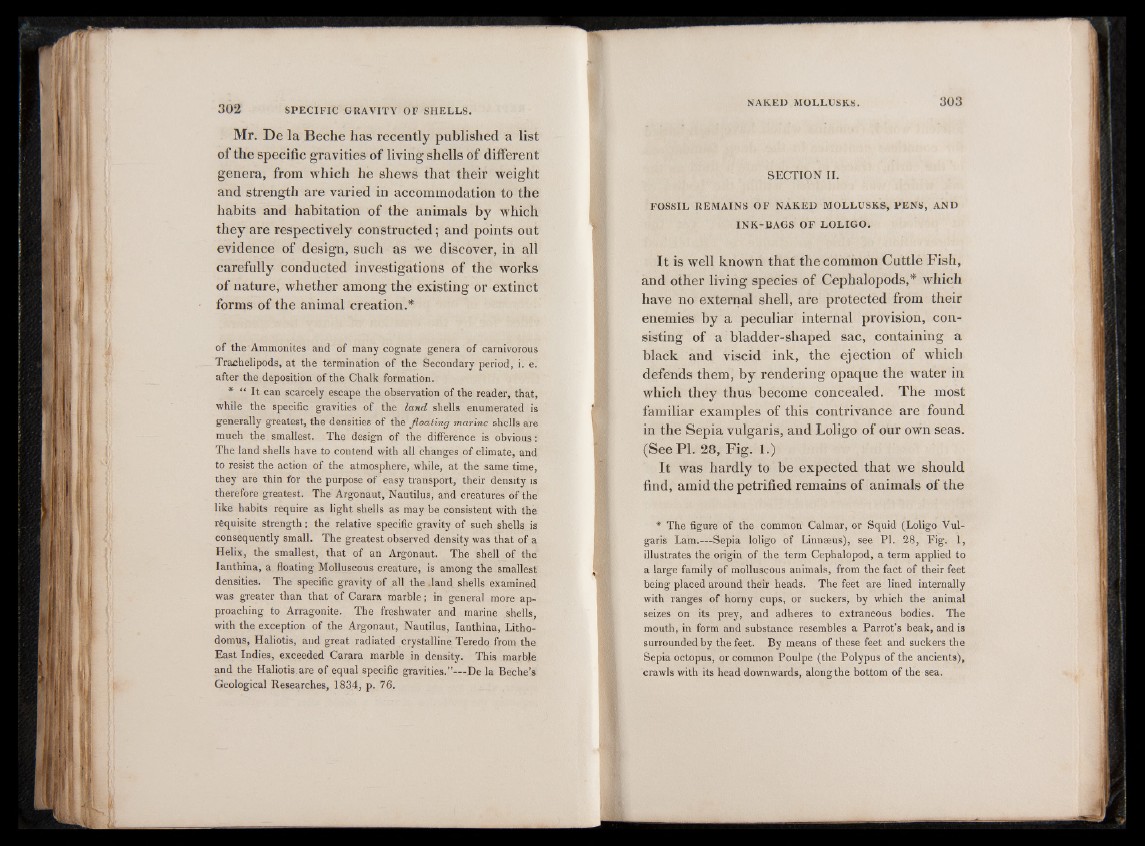
Mr. De la Beche has recently published a list
of the specific gravities of living shells of different
genera, from which he shews that their weight
and strength are varied in accommodation to the
habits and habitation of the animals by which
they are respectively constructed; and points out
evidence of design, such as we discover, in all
carefully conducted investigations of the works
of nature, whether among the existing or extinct
forms of the animal creation.*
of the Ammonites and of many cognate genera of carnivorous
Trachelipods, at the termination of the Secondary period, i. e.
after the deposition of the Chalk formation.
* “ It can scarcely escape the observation of the reader, that,
while the specific gravities of the land shells enumerated is
generally greatest, the densities of the floating marine shells are
much the smallest. The design of the difference is obvious:
The land shells have to contend with all changes of climate, and
to resist the action of the atmosphere, while, at the same time,
they are thin for the purpose of easy transport, their density is
therefore greatest. The Argonaut, Nautilus, and creatures of the
like habits require as light shells as may be consistent with the
requisite strength; the relative specific gravity of such shells is
consequently small. The greatest observed density was that o f a
Helix, the smallest, that of an Argonaut. The shell of the
Ianthina, a floating Molluscous creature, is among the smallest
densities. The specific gravity of all the .land shells examined
was greater than that of Carara marble; in general more approaching
to Arragonite. The freshwater and marine shells,
with the exception of the Argonaut, Nautilus, Ianthina, Litho-
domus, Haliotis, and great radiated crystalline Teredo from the
East Indies, exceeded Carara marble in density. This marble
and the Haliotis are of equal specific gravities.”— De la Beche’s
Geological Researches, 1834, p. 76.
NAKED MOLLDSKS. 303
SECTION II.
FOSSIL REMAINS OF NAKED MOLLUSKS, PENS, AND
INK-BAGS OF LOLIGO.
It is well known that the common Cuttle Fish,
and other living species of Cephalopods,* which
have no external shell, are protected from their
enemies by a peculiar internal provision, consisting
of a bladder-shaped sac, containing a
black and viscid ink, the ejection of which
defends them, by rendering opaque the water in
which they thus become concealed. The most
familiar examples of this contrivance are found
in the Sepia vulgaris, and Loligo of our own seas.
(See PI. 28, Fig. 1.)
It was hardly to be expected that we should
find, amid the petrified remains of animals of the
* The figure of the common Calmar, or Squid (Loligo Vulgaris
Lam.— Sepia loligo of Linnaeus), see PI. 28, Fig. 1,
illustrates the origin of the term Cephalopod, a term applied to
a large family of molluscous animals, from the fact of their feet
being placed around their heads. The feet are lined internally
with ranges of horny cups, or suckers, by which the animal
seizes on its prey, and adheres to extraneous bodies. The
mouth, in form and substance resembles a Parrot’s beak, and is
surrounded by the feet. By means of these feet and suckers the
Sepia octopus, or common Poulpe (the Polypus of the ancients),
crawls with its head downwards, along the bottom of the sea.